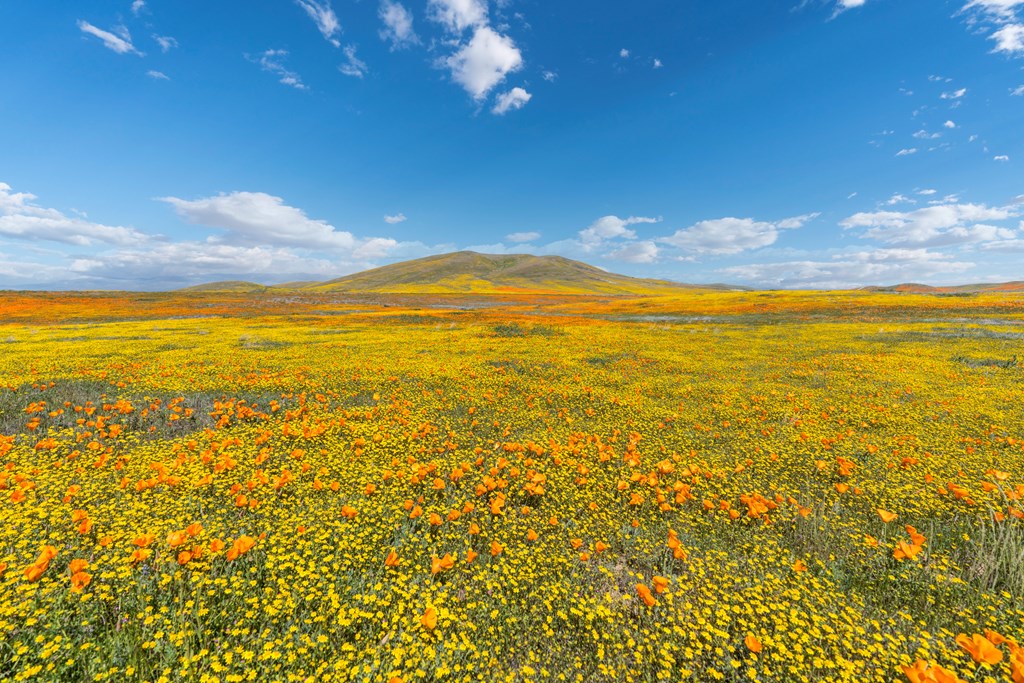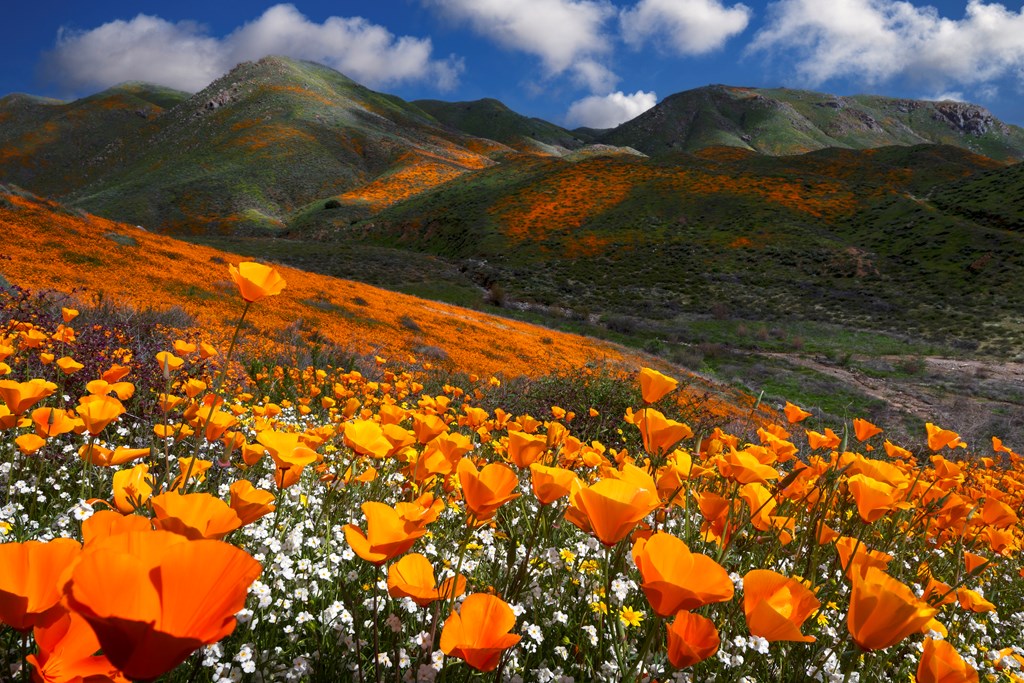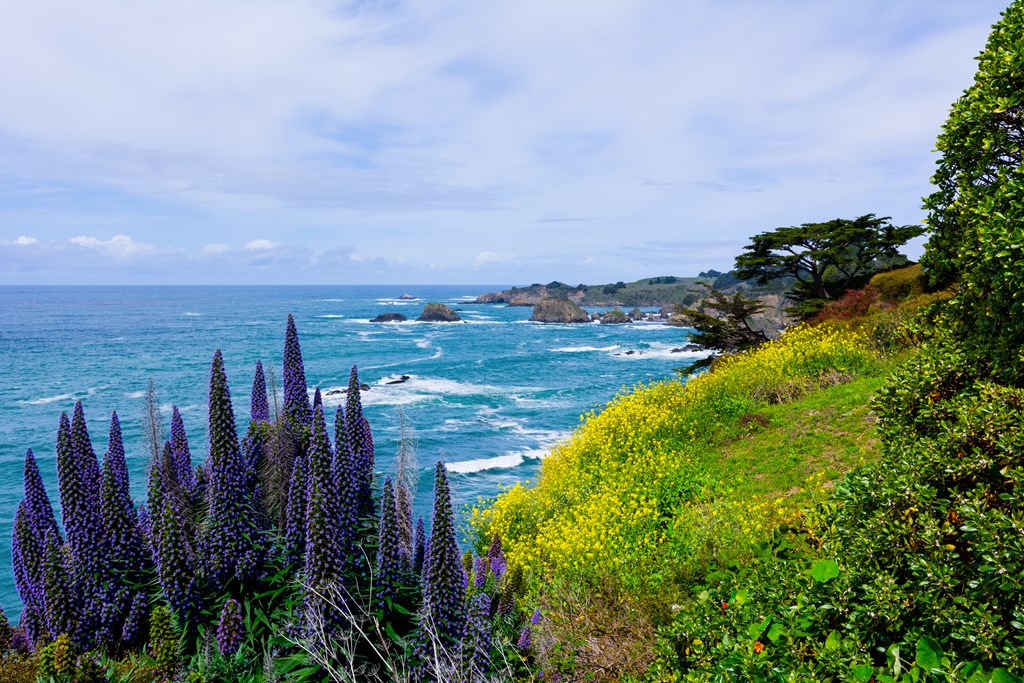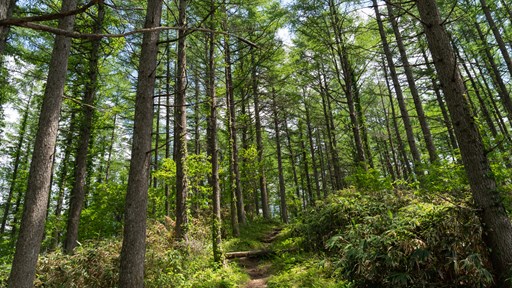Usually, California is known for its entertainment industry, blue waves, surfing and the architectural beauty of the Golden Gate Bridge. At the beginning of spring, though, thousands of people arrive to glimpse a natural phenomenon known as the California super bloom.
Each year, the super bloom changes slightly in color, scale and beauty depending on the weather conditions that precede it. Sometimes, it lasts for a week, and other times, visitors are lucky if it lasts for several. Like all things magical, the super bloom is unpredictable and exciting when it appears.

What Is the Super Bloom?
The California super bloom is a natural phenomenon that transforms part of the state’s landscape into a rich tapestry of vibrant colors. The flowers tend to be a mix of wildflowers, but in some areas, the dominant flower is the poppy.
Why is a field or valley of flowers so special? The answer is that it often only happens once a decade. Recently, however, the super bloom has appeared more frequently, which many suggest could be because of climate change and the weather being warmer than usual. The event occurs when there is a higher-than-average rainfall followed by a prolonged drought, leading to a natural growth spurt among the wildflowers.
The last super bloom happened in 2019, especially in the Death Valley area. Unfortunately, the event went viral on social media, and an unusually high number of visitors descended on the area. The locals were not prepared, and there was miscommunication about how to be mindful of the flowers and treat the environment, causing what is now known as the “Poppy Apocalypse.”
Parks and the local municipalities are now prepared. They have made changes to the rules and regulations around Death Valley National Park and other bloom areas to allow for safer and better experiences during this exciting occurrence.
The best way to enjoy the super bloom for yourself is to be right near the scene, and staying at one of the Kampgrounds of America locations in the area puts you there. Bring your family, friends and pets and start creating a family tradition of being together surrounded by the beauty of nature.

What Are the Flowers in Bloom?
From a distance, the valleys and fields just look like a wildfire of red and oranges — but if you look closer, you will see the individual beauty of each wildflower. Here are some of the more dominant ones you can find blooming in early spring:
- California poppy (Eschscholzia californica): Bright, eccentric orange, soft cup-shaped flowers are the iconic signatures of California’s state flower, the California poppy. During the day, you can see its fragile petals wave in the breeze, but at night, the flower closes. Sometimes, it will even do this on cloudy days. This behavior is called nyctinasty, which is believed to be the flower’s attempt to protect its seeds from potential rain.
- Lupine (Lupinus spp.): Lupine grows tall stalks that feature vibrant flowers with small petals. It blooms in an array of colors from pinks to purples and even a splash of orange. Its leaves are arranged in a palmately compound shape, which means they spring forth from the ground in a finger-like pattern. Lupine is found naturally in the U.S. but also in North Africa and in the Mediterranean. Lupine is a legume, so some of its relatives include chickpeas, acacia and green beans. What makes these types of plants unique is their ability to replenish the soil with nitrogen, making them an important part of the ecosystem.
- Desert gold (Geraea canescens): From a distance, the desert gold flower looks like someone sprinkled golden dust on the soil, and it is a sharp contrast to the color of the ground. The plant has evolved to have several adaptations that help it grow in barren land. It has developed hairy leaves to reduce its water loss and has a unique root system designed to maximize water update. Another name for this bright yellow flower is the desert sunflower.
- Tidy tips (Layia platglossa): Tidy tips carpet areas with their sunshine-filled yellow petals and their graceful white edging. For many, this flower signals the official beginning of spring. It is native to western North America and is a very easygoing plant in terms of maintenance and drought tolerance.
- Phacelia (Phacelia spp.): Other common names for this highly unusual flower are heliotrope and scorpionweed. You can tell by its lilac coloring that the phacelia is part of the borage family. The unique flower has several stalks at the end, all covered with small, delicate purple flowers. The flower has a soft feel to it, caused by the extension of its stamen. There are a number of different varieties of the phacelia, but they all have the signature bell-like flower. The two most common are the lacy phacelia, or tansy-leafed phacelia, and the California bluebell.
- Owl’s clover (Castilleja exerta): The owl’s clover is a beautiful pink flower. A lot of what you think are flowers are actually colored bracts, which are modified leaves. It is found in the western part of the U.S. and is very common in California. It also does very well in the Mediterranean, but it is not native to that region.
- Desert sand verbena (Abronia villosa): Another visually striking flower, the desert sand verbena, provides a splash of magenta to the otherwise dry sand of the Southwest regions of the U.S. The flower emits a strong fragrance, especially in the evening, attracting both bees and moths for its pollination.
- Desert five-spot (Eremalche rotundifolia): In sandy, gravel types of soils, you will find a gorgeous and unusual plant. The desert five-spot is a magenta color on the outside, with a paler pink on the inside of the petals. From the side, it appears in a ball-type shape, and when you peer inside, you will have five red spots, one at the base of each petal. The overall plant is a bushy 4 to 16 inches tall.

Where to See Super Bloom 2024
Hopefully, there is a super bloom this year. However, it is difficult to predict since there are several factors that need to be just right.
If there is a super bloom, there are a number of regions you could visit, such as Central California, the desert basin area, Northern California and the Bay Area. Each location has its different types of flowers and displays, but all of them show off an amazing canvas of color under the California blue sky.
Meadows and Coast
California’s coastline and green valleys are rich in oranges and yellows in spring. Here are some areas along the coast and Central California meadows that could potentially super bloom:
- Antelope Valley: The Antelope Valley is rich with California poppies, purple lupine and cream cups. This area often has a mid to late-spring bloom, so if you miss the first batch of flowers, then you can always come to Antelope Valley to see the later varieties. No matter when you visit, you will see the rolling hills ablaze in a multitude of colors. In the last few years, the area has become a hot spot for social media influencers, so just check beforehand with the location and ensure you follow the rules and respect the area.
- Buttonwillow and Central California: Tidy tips, phacelia, goldfields and owl’s clover all bloom in the hills of Buttonwillow and Central California. The bloom in this area can be extensive, going far beyond the horizon in a carpet of color. Flowers tend to distribute their seeds near each other and blossom altogether, creating a patchwork effect across the valley.
- Point Reyes: Along the coast is an area known for its Douglas irises, coastal lupine and even a splash of California poppies. The wild coastal scenery combined with the wildflowers makes this area unique, especially if you get an angle with the ocean as the backdrop. Compared to the other regions, the super bloom here starts fairly early in mid-to-late February and can extend all the way to the end of spring.

Desert
Desert regions are not often thought of as vibrant places with lush flowers, but you will be surprised how they pull out all the stops come springtime. The arid, hot, dry soil strikes a different chord with the vibrant colors that come alive in the shrubs, bushes and ground cover as they showcase their color. Here are some of the best places to see the super bloom:
- Death Valley: The Death Valley wildflower forecast for 2024 is looking pretty good. As we get closer to spring, have a look at the temperature and rainfall to see if it will happen this year. Flowers that will show their colors are usually desert gold and five spot, and you could even see some phacelia. This region displays early, from mid-to-late February.
- Anza Borrego Desert: Patches of desert sunflowers, poppies and verbena create a colorful display against the backdrop of the desert mountains and clear blue sky. These flowers are all tremendously hearty to be able to survive in this area. When you visit, be mindful of wildlife as well — a lot of wild animals, including bighorn sheep, iguanas and birds, thrive on the increased biodiversity during the blooming season.
- South Fork Valley: The South Fork Valley offers a different array of wildflowers than the others. You will likely be able to see Mojave aster and blossoms of the Joshua tree among the poppies and lupine. You can find their splash of color toward the end of the season. The reason for the variation is that the valley is in a high-desert environment, as well as a mountain climate.
- Red Rock Canyon: A dramatic setting for wildflower viewing is the canyons. They display cholla cacti and yucca with a mix of brittlebush and monkeyflowers. The red rock provides an otherwordly contrast with the vivid blooms.
Etiquette and Conservation
The super bloom requires everyone to be mindful and treat the occasion with utmost care. Each area and location will have its own set of rules and regulations to guide visitors on how to practice responsible etiquette and conservation while experiencing this one-of-a-kind natural event. However, here are some general things you can plan to do:
- Stay on the trails: Walking off the trails can damage or kill wildflowers, which often have shallow roots. In addition to protecting the flowers, staying on the established trail helps to preserve the habitats of numerous small animals and wildlife that have made these fields of flowers their home.
- Leave no trace: Picking wildflowers is illegal for many reasons, but one of the big ones is there would be fewer seeds to support the super bloom in future seasons. Also, remember to pack up all trash, including anything organic, like fruit peels.
- Respect the wildlife: Always observe wildlife quietly and from a distance. Feeding or trying to touch wildlife can be harmful to both you and the animal.
- Noise levels: Keep noise levels to a minimum and enjoy the tranquillity of nature. If you want to listen to music, pack earpieces so you don’t disturb the surrounding environment and other visitors with noise pollution.
- Plan your visit: Ensure you have the correct permits and tickets to enter an area. Check the weather and pack the appropriate clothing. Don’t forget supplies like water and sunblock.
Camping at KOA During the Super Bloom in California
With over 500 locations across North America, you can find a KOA Campground that is close to where you want to take in the unforgettable California super bloom. Once you decide if you are going to head to the coast, valley or desert, you can use our online location map to find the nearest KOA Campground.
Each campground is specifically designed with user comfort in mind. Choose from a variety of ways to stay, such as Tent Sites, RV Sites and Deluxe or Camping Cabins, to make your visit convenient and easy. If you go camping often, consider signing up for KOA Rewards. Get ready for the experience of a lifetime and book your campsite today!
About the Author: Kampgrounds of America
Kampgrounds of America is the largest system of open-to-the-public campgrounds in the world, with over 500 locations across the United States and Canada. Founded in Billings, MT in 1962, KOA’s family of campground brands – KOA Journey, KOA Holiday and KOA Resort – today serve more than a million camping families each year. KOA is dedicated to “connecting people to the outdoors and each other” by providing people with a variety of camping experiences and the information they need to make the most of their camping trip. Read more of their camping and travel resources by visiting KOA.com/blog.

























